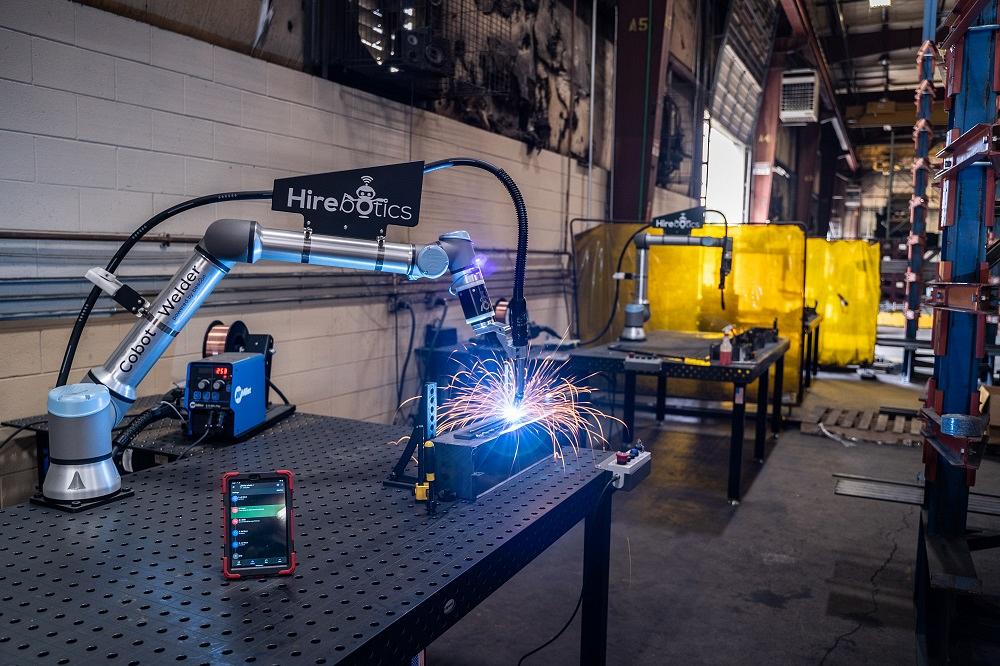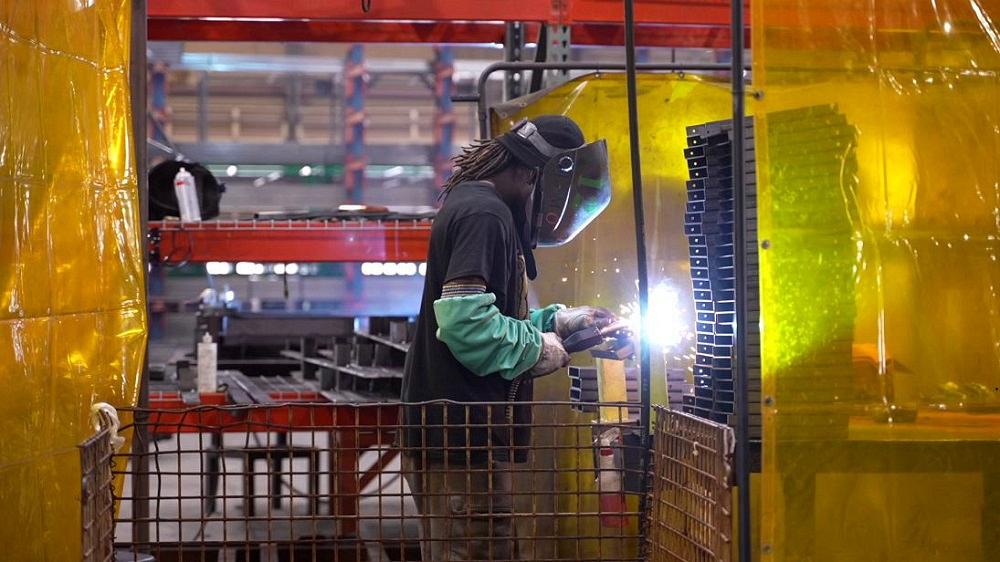CEO
- FMA
- The Fabricator
- FABTECH
- Canadian Metalworking
Categories
- Additive Manufacturing
- Aluminum Welding
- Arc Welding
- Assembly and Joining
- Automation and Robotics
- Bending and Forming
- Consumables
- Cutting and Weld Prep
- Electric Vehicles
- En Español
- Finishing
- Hydroforming
- Laser Cutting
- Laser Welding
- Machining
- Manufacturing Software
- Materials Handling
- Metals/Materials
- Oxyfuel Cutting
- Plasma Cutting
- Power Tools
- Punching and Other Holemaking
- Roll Forming
- Safety
- Sawing
- Shearing
- Shop Management
- Testing and Measuring
- Tube and Pipe Fabrication
- Tube and Pipe Production
- Waterjet Cutting
Industry Directory
Webcasts
Podcasts
FAB 40
Advertise
Subscribe
Account Login
Search
How to attract new welders with advanced technologies
Cobots, software, mobile apps, and recruiting the next crop of skilled tradespeople
- By Rob Goldiez
- Updated May 5, 2023
- December 9, 2022
- Article
- Automation and Robotics

There are strategies to help any welding or manufacturing team looking to hire skilled welders or the few-and-far-between newcomers to the practice of welding–and they start with technology.
The welder shortage has plagued manufacturers and fabricators for years. A global pandemic, a shifting job market, and generational trends only have exacerbated the matter.
On the one hand, many experienced welders—those tried-and-true pros who have seen it all—edge increasingly closer to retirement or, because of burnout or disenchantment, embark on entirely new careers. On the other hand, as the manufacturing sector knows all too well, millennials and Generation Z (and even Generation Alpha) have an entirely different perspective on working in production or manual jobs.
Despite the staffing doom and gloom, strategies exist that can help any welding or manufacturing team looking to hire skilled welders or the few-and-far-between newcomers to the art of welding.
It starts with technology.
Needless to say, it takes a multipronged approach to attract and retain top talent, regardless of a candidate’s age. However, it is important never to underestimate the power of technology to lure the best applicants in the field.
The Welders With the Cred: Are They Really That Technophobic?
The simplistic answer would be yes. Older welders get down to brass tacks, do the job, and call it a day. No need for any fancy tech here.
The weathered welders may be skeptical about advanced technologies, such as traditional robotic welding systems or new welding cobots. The sheer fear of losing control over their jobs is real, as is apprehension about being fired as a business relies more and more on robotic automation.
While it stands to reason some older welders prefer the same way of doing things, there is an inkling of hope. They can be swayed by understanding the true benefits that welding cobots, app-based solutions, and other technologies can bring to the table.
Think of it this way: Welding is tough, it can be dangerous, and it can be hard work. Skilled welders may feel threatened that robots will take over their jobs. However, if you educate them on the advantages of automated welding systems, you can change the conversation entirely.
Imagine telling your welders that welding robots will handle all the mundane and repetitive jobs. Envision a follow-up conversation explaining that they can work on more complex, important, and strategic tasks. It may take them a bit of time at first, but if you involve them in your Industry 4.0 project right from the start and invest in training, you are likely to notice earlier adoption than you ever thought possible.

It is important never to underestimate the power of technology to lure the best applicants in the field. Images: Hirebotics
Entice Tech-First New Welders
The World Economic Forum states that millennials and Generation Z will make up more than half the workforce by 2025, with Gen Z–or those born between the mid-1990s and late 2000s–to make up about 27% of the workforce. That is just a few years away.
Gen Z has different work priorities, as the World Economic Forum explains in a 2022 article. According to its findings:
- They are less concerned with salary.
- They want to work for companies that share their values and foster a work/life balance.
- “Implementing training and reskilling programs” is one of the top five ways to attract and retain the future workforce.
New generations, regardless of year cutoffs, have one thing in common: Tech plays an integral part of their day-to-day lives. They focus on being up to date on the latest technology that makes their lives easier. They navigate easily through fresh new approaches to work.
Don’t expect to win over up-and-coming welders with outdated technology. Gone are the days when potential employees were attracted to—or even want to deal with—legacy technologies, including cumbersome and lackluster MS-DOS-like robotic operating systems. In an era of video streaming services and social media, manufacturing jobs really need to level up in the eyes of prospective staff members.
Generations Y, Z, and beyond have been conditioned to use technology platforms at work to eliminate redundancies and eradicate inefficiency.
Several studies, including one recently conducted by Dell, reveal the tech savviness of Gen Z. The Dell study reported 80% of Gen Z aspires to work with cutting-edge technologies, 77% are willing to be technology mentors to co-workers, and a jarring 91% indicate the technology an employer offers would influence their job choice when comparing similar job offers.
To boost the curb appeal of open welder positions, fabrication shops and manufacturers inevitably need to invest in technologies that can upskill welders and tap into their curiosity and creativity.
New solutions like welding cobots and dedicated apps democratize technology and lower the barrier of entry. These solutions can be adapted to the trade and to all business sizes.
For instance, traditional welding robots are difficult to set up, require a lot of time to program, and are not suited for companies that deal with high-mix/low-volume production. However, welding cobots, especially those using dedicated apps, require no robotics knowledge. They not only leverage the expertise of current welders but also alleviate some of the gripes they have with their jobs.
These new automated welding systems often are designed for fast onboarding and minimal programming. The end result? Younger welders feel as though the companies they work for actually invest in their potential and contribute to advancing their careers.
Adopt New Methods to Attract New Welders
In the current labor market where it is tough to find qualified and dedicated welders, businesses will have no choice but to adopt new work methods and equipment to transform welding from a manual and dangerous job into a cognitive career that is valued and highly coveted. New technologies, such as welding robots and cobots, are providing highly compelling growth opportunities for welders of all generations.
About the Author
Rob Goldiez
2901 Armory Drive, Suite 106
Nashville, TN 37204
(615)--80-0-26
About the Publication
subscribe now

The Welder, formerly known as Practical Welding Today, is a showcase of the real people who make the products we use and work with every day. This magazine has served the welding community in North America well for more than 20 years.
start your free subscription- Stay connected from anywhere

Easily access valuable industry resources now with full access to the digital edition of The Fabricator.

Easily access valuable industry resources now with full access to the digital edition of The Welder.

Easily access valuable industry resources now with full access to the digital edition of The Tube and Pipe Journal.
- Podcasting
- Podcast:
- The Fabricator Podcast
- Published:
- 04/16/2024
- Running Time:
- 63:29
In this episode of The Fabricator Podcast, Caleb Chamberlain, co-founder and CEO of OSH Cut, discusses his company’s...
- Industry Events
16th Annual Safety Conference
- April 30 - May 1, 2024
- Elgin,
Pipe and Tube Conference
- May 21 - 22, 2024
- Omaha, NE
World-Class Roll Forming Workshop
- June 5 - 6, 2024
- Louisville, KY
Advanced Laser Application Workshop
- June 25 - 27, 2024
- Novi, MI
































